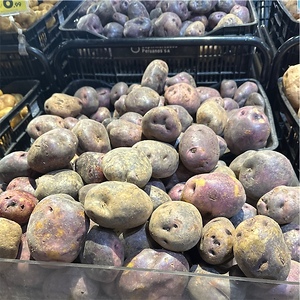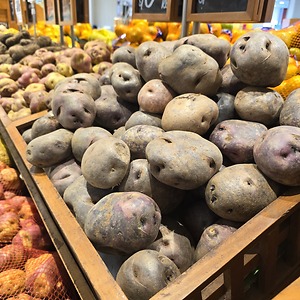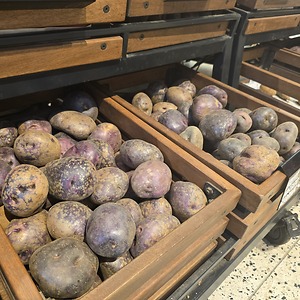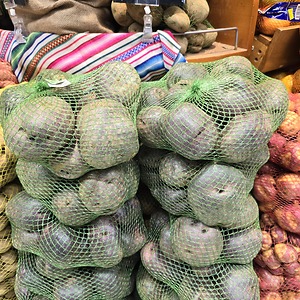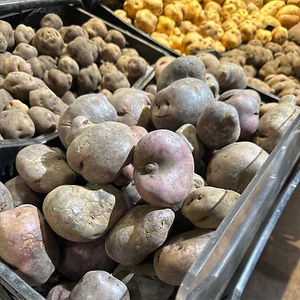


Andina Potatoes
Estimated Inventory, lb : 0
Description/Taste
Andina potatoes vary in size, shape, and overall appearance, depending on the specific variety. The tubers are generally round, oval, or slightly flattened, featuring taut, semi-smooth, textured skin. Some varieties will feel coarser than others, and the skin ranges from thin to thick, with light brown, dark brown, purple-black hues. Tiny holes, raised rough patches, and various flecks and spots are scattered across the surface, and shallow to deep-set eyes sometimes give the tubers an irregular shape. Underneath the surface, the flesh is dense, firm, and slippery when raw, softening to a tender, fluffy, creamy, to lightly grainy consistency when cooked. Andina potatoes typically encompass varieties of white-fleshed potatoes grown in the Andes mountains, but some vendors broaden the term to Andean-grown varieties with yellow flesh. The definition of an Andean potato varies with each region and market, and the term is used throughout Peru. Andina potatoes are edible once cooked and have a mild, subtly sweet, neutral, earthy, and sometimes bitter taste.
Seasons/Availability
Andina potatoes are primarily available in the dry season, with peak production from April through October.
Current Facts
Andina potatoes, botanically classified as Solanum tuberosum, are a category of potato varieties belonging to the Solanaceae or nightshade family. The name Andina translates from Spanish to “Andean” and is a descriptor for potato varieties grown in the Andes mountains. This term is a marketing name used throughout commercial markets in Peru to distinguish between potatoes grown in the Andes and standard varieties of potatoes grown in other regions, generally known as Papas Blancas. Andina potatoes are also known as Andina Blanca and Andina Negra in some markets. Potatoes grown at high elevations in the Andes mountains are believed to be grown without fewer chemicals as the tubers are hardy and can withstand harsh growing conditions in poor soils and extreme climates. Andean potatoes are also believed to have some disease resistance and are viewed as having a richer flavor and texture due to their growing regions. It is important to note that Andina is often a category representing many different varieties of potatoes that may vary slightly in appearance, as the name is sometimes loosely used. Over time, the category has also become a broad marketing term for yellow and white-fleshed market types. Andina potatoes are sold in Peruvian commercial markets as an all-purpose cultivar. The potatoes are purchased for everyday cooking and are used in a wide array of savory culinary preparations.
Nutritional Value
Andina potatoes have not been extensively studied for their nutritional properties, and each variety will vary in nutritional content. Potatoes, in general, are a source of potassium to balance fluid levels within the body, phosphorus to build bones and teeth, fiber to regulate the digestive tract, and some calcium to protect bones and teeth. Potatoes also provide magnesium to control nerve functions, manganese to form connective tissues, vitamin C to strengthen the immune system, and other nutrients, including zinc, iron, vitamin K, and folate.
Applications
Andina potatoes have a mild, neutral taste suited for cooked preparations. This category of potatoes typically represents varieties that are used as an all-purpose ingredient and are favored for remaining mostly firm without completely breaking down. In Peru, Andina potatoes are popularly incorporated into soups, stews, and chowders. One notable dish utilizing white-fleshed potatoes is called cau cau, an Afro-Peruvian Creole stew made from finely chopped cuts of meat and potatoes. Andina potatoes can also be added to casseroles, steamed with fresh herbs as a side dish, or used as the central ingredient in various potato salads. Some varieties of Andina are pureed as a thickener for sauces or dried and ground into flour. While less common, Andina potatoes are occasionally used as a variation in the classic causa recipe, substituting for the traditional, yellow-fleshed cultivars. Andina potatoes pair well with meats such as beef, pork, and poultry, seafood, vegetables including bell peppers, carrots, and legumes, cheeses such as queso fresco, parmesan, and mozzarella, and herbs including mint, cilantro, and parsley. Whole, unwashed Andina potatoes can be stored for several months when kept in a cool, dry, and dark location.
Ethnic/Cultural Info
In the Andean highlands, a famous Incan archeological site is hypothesized to be connected to ancient potato cultivation. Moray is a site in the Maras district of the Cusco region of the Peruvian Andes, found along the slope of the Wañinmarca mountain. The archeological site is approximately 3,550 meters above sea level and is comprised of circular stone terraces known as muyus. Each stone terrace features a flat, curved piece of soil, and several types of soil have been found at varying levels in the terraces, leading scientists to theorize that soil types from all over the Inca empire were carried into this site for agricultural purposes. There are also four main sections within the site, each at varying elevation levels. Moray was known among indigenous populations of the region for centuries and was first noted among records of visiting Western Archaeologists in 1931, especially American geologist Robert Shippee. Later in the 1970s, Australian physicist John Earls discovered temperature differences between the levels within the terrace. This newly uncovered detail made scientists speculate that the terraces were used as small microclimates for agricultural crop evaluations. While these claims are only theories and have not been proven, many scientists have attributed the wide variation in potato varieties from the Andes to extensive cultivation among ancient empires in such sites. Other scientists hypothesize that Moray may be a ceremonial site, and the location is still heavily debated. Communities surrounding Moray host annual celebrations known as the Fiesta de Moray in October at the site of Moray. During the festivities, agriculture is celebrated through cooking traditional crops, including potatoes, and live entertainment, such as folk dancing, is conducted to celebrate and educate visitors on the region’s cultural heritage and history.
Geography/History
Andina potatoes are native to regions of the Andes mountains and have been growing wild since ancient times. In Peru, potatoes are thought to have been first domesticated over 10,000 years ago in the Andes, and the oldest archeological findings were sourced from areas around Lake Titicaca. Ancient potato varieties were initially bitter and were selectively bred throughout history for improved flavor, texture, and cultivation characteristics, eventually becoming one of the most essential crops within the Andes. Over time, new varieties were created throughout the Andes, and each type had varying culinary qualities. The name Andina is a catch-all term for white and sometimes yellow-fleshed potato varieties grown in the Andes mountains in Peru. This descriptor represents a category rather than an individual variety, and Andean potatoes are typically found in select regions of the mountains at high elevations from 3,500 to 4,200 meters. Today, Andina potatoes are cultivated in the areas of Cusco, Ayacucho, Huancavelina, Arequipa, Huánuco, Junín, and Apurímac and are sold in commercial markets throughout Peru. The Andina potatoes featured in the photograph above were sourced through local markets in the Miraflores district of Lima, Peru.



